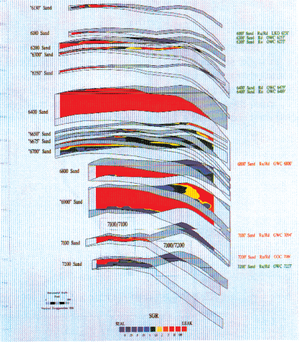Migration pathway map construction
| Exploring for Oil and Gas Traps | |

| |
| Series | Treatise in Petroleum Geology |
|---|---|
| Part | Predicting the occurrence of oil and gas traps |
| Chapter | Evaluating top and fault seal |
| Author | Grant M. Skerlec |
| Link | Web page |
| Store | AAPG Store |
A migration pathway map is a fundamental tool for prospect assessment and field development. In simple migration pathway maps, arrows are drawn perpendicular to structural contours. However, migration pathway maps must also define those faults and those parts of faults that juxtapose sand with sand as well as those faults that cross-seal or cross-leak and dip-seal or dip-leak.
Requirements for map construction
The following table lists the requirements for constructing a migration pathway map.
| Requirement | Explanation |
|---|---|
| Structure–depth maps | Defines buoyant vectors for hydrocarbon migration |
| Fault plane profile | Defines sand-sand and sand-shale juxtaposition and potential juxtaposed lithology leak points (JLLPs) |
| Quantitative fault plane analysis | Defines real JLLPs, areas of cross-seal or cross-leak, and areas of dip seal or dip leak |
Example: fault controlling migration
Figure 1 illustrates how completely a fault can control migration pathways across a fault. In this fault plane profile of a fault in a Gulf Coast field, the shale gouge ratio (SGR) was calculated and contoured only on areas of sand-sand juxtaposition. Areas of sand-shale juxtaposition are uncolored. No hydrocarbon migration will occur across these uncolored regions or across the sand-shale juxtapositions with low SGRs (blue-purple). These high SGR areas are essentially holes for fluid migration in the fault plane. It will only occur across the areas of sand-sand juxtaposition with high SGRs (red-orange).
See also
- Fault seal and migration pathways
- How faults control trap fill and migration pathways
- Effect of seal on hydrocarbon yield estimates
